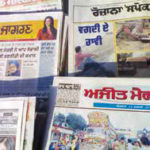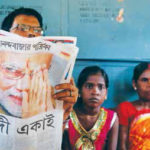Print still more trustful than digital
Despite the wave of digital media rising all over, there is still a lot (or some) about printed newspapers playing a pivotal role in the news media industry—a lot indeed in India, where the regional domain remains a breeding ground for vernacular dailies and weeklies. JYANESWAR LAISHRAM takes a look at this, focusing on both domestic and overseas markets.
 Headwind buffeting the printed newspapers is a reality—a reality that holds true little in India and in a bigger magnitude in the overseas. It is little in India because the country’s printed newspaper market as on today has a different characteristic, which is vibrant and promising for sustainability to an extent, for around two decades down the line, as per industry experts. In this viewpoint, trust is the point that won’t go away, whether in India or overseas.
Headwind buffeting the printed newspapers is a reality—a reality that holds true little in India and in a bigger magnitude in the overseas. It is little in India because the country’s printed newspaper market as on today has a different characteristic, which is vibrant and promising for sustainability to an extent, for around two decades down the line, as per industry experts. In this viewpoint, trust is the point that won’t go away, whether in India or overseas.
When it comes to trust that industry leaders with varied temperaments are dealing with its inclination in very different ways, we can also study what is reeling in the international arenas. In this respect, Kantar—a Data Investment Management division of WPP, one of the world’s largest insight, information and consultancy groups—has revealed the overall attitudes of 8,000 news consumers in the US, UK, France and Brazil, saying that the ‘trust’ arguably transcends simple attention metrics.
What it unearthed by Kantar is that traditional print and broadcast media brands have proven more resilient to accusations of ‘fake news’ than social media platforms and digital news outlets, as news consumers are reading more widely and becoming more sophisticated in their engagement with news content. In this, public or readers believe ‘fake news’ had an impact on some key events or occasions in the recent past; for example: US Elections, but it has been maintained that quality journalism eventually wins and still important for democracy.
Strength of ‘trust’
Eventually, what is notable in the realm of printed newspaper is the strength of ‘trust’. In the Kantar findings, it has been revealed that printed news magazines are now rated to be the most trusted news source (72 percent rate them positively), closely followed by 24-hour TV news, radio bulletins and national newspapers. On the other side so conversely, around 33 percent of the surveyed readers agreed that social media ‘provides news they can trust’. In the study, even printed versions of national newspapers in the surveyed region, mentioned above, are rather trusted higher than those websites of the same organisations.
Fake news mayhem
Everybody knows news accessed via social media platforms takes many forms — from the simple sharing of current news-related opinions and comments with friends, to the in-stream consumption of content distributed by mainstream news organisations in an authentic and reliable manner. What is particularly interesting, regardless of the mode of social news consumption, is the impact of the pervasive topic of fake news on people’s trust in
social news.

In all aspects of fake news, social media news has taken quite a battering. In the samples of survey findings, 58 percent respondents said they would no way trust coverage of politics and election news on social media as a result of fake news scandals. In the sample, around 24 percent of them declined levels of trust in mainstream news—the figure is low when compared to social media.
Importance of news brands
Basically, what it is important to an extent is the news brands because a line can be drawn between trust and monetisation. At a time when newspaper with its brand is looking to protect, diversify and digitise its revenue streams, trust is what it takes to make an impress to its readers, more than ever. In the Kantar survey, 29 percent of respondents said they paid for authentic online news uploaded by well known brands last year. The number of such subscribers who trusted towards the newspaper brands to 42 percent. In this, around 40 percent bought printed newspaper for authentic and trustful news. In an overall count, 56 percent said they still trust in printed newspapers than digital versions.
Brand awareness
The friction always exists between news publisher and social media platforms in an increasingly complex manner. Ad revenues of the publishers that have been gobbled up by social media and online news platform provide a vital traffic lifeline to news publishers. Printed newspapers or traditional media are already wary about their dependence on audiences driven to them by social media, but when nearly two-thirds of social news consumers said they are very much aware of which news organisation provides the content they are reading on social media platforms. In this networked world, again to say ‘trust’ is the most important currency!
On domestic ground
With what all hovering around in the overseas domain, the strong driving force in the Indian newspaper market is still the print. Hindi and vernacular newspapers, particularly in the regional arenas, and in some big cities and metros as well, are accelerating with the launch of new editions and enhancement in print quality. For example, National Duniya, a Hindi daily that has remained dormant for a period of time, has recently made a comeback with its Delhi edition. Likewise, various regional printed dailies and weeklies in south, east and many parts of the country have recently been popping up, in response to fresh demand for them, showing fervour of sustainable revival of printed newspapers in India.





